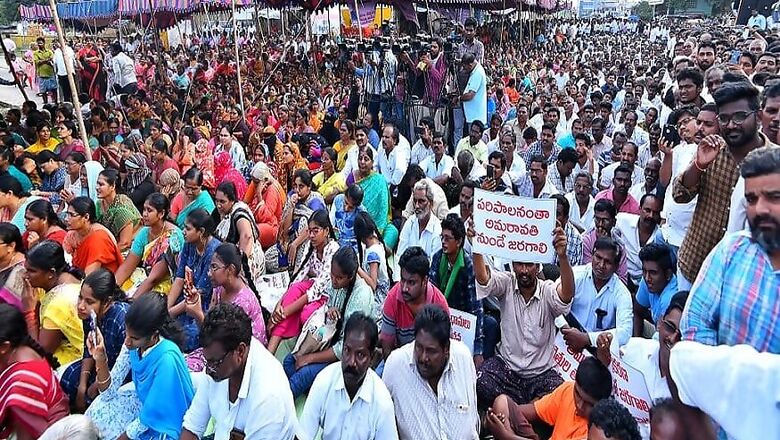
views
Hyderabad: Thirty-five-year-old Swarnamma struggles to hold back her tears. The farmer and mother-of-two finds herself in completely unfamiliar terrain.
“I am not used to this protest culture and never thought I would have to participate in one,” she tells News18. “With me are these hundreds of women farmers who are sitting on the roads today. We all gave up our lands thinking there would be urbanisation and development.”
There’s growing unrest in Andhra Pradesh’s Amaravati region as over 20,000 farmers have been unremittingly protesting against the YS Jagan Mohan Reddy government’s intention to shift the state capital. The cultivators around here gave up their fertile lands years ago hoping for a “world-class city”.
It’s been about twenty days since the protesters took to the streets. They’ve called for shutdowns, sat on the roads, shouted slogans and say they will continue to do so until the government withdraws the plan to move the capital.
Like Swarnamma, Amaravati is full of farmers who had never participated in protests before. However, all hell broke loose after chief minister YS Jagan Mohan Reddy, in December, indicated a plan of having three capitals – including Visakhapatnam, and Kurnool – thereby greatly reducing the importance of Amaravati.
He also said that this move could ensure “decentralised development”, adding that a “grand capital Amaravati”, as proposed by his predecessor N Chandrababu Naidu, would require an investment of one lakh crore rupees that neither the state nor Centre can afford at this point.
After Telangana was carved out of the state in 2014 and Hyderabad went with it, the Andhra Pradesh government pooled 33,000 acres of land from farmers in 29 villages of the Amaravati region, promising a world-class mega capital. The previous government, led by Naidu, had assured of a “nine-zone” developed capital city in that area which would include an IT Park, a horticulture hub, educational institutions, etc. The farmers were told that the structure would be similar to that of cities in Singapore.
“Most children in my village move to Hyderabad for higher studies because all we have here is agriculture. I gave my 18 acres of land which was a legacy of my ancestors, only with the longing that a city here would make my children and grandchildren stay here with me. If there are colleges and jobs, my kids would not have to leave,” said 68-year old farmer Chennaiah from Thullur.
The deal, with the past government, was that the farmers give away their land which was spread over 29 villages, and in return they were promised a slew of benefits such as residential and commercial plots, a compensation of about 40,000 rupees per acre ever year for the next 10 years, better surroundings, with jobs for their children, affordable and quality education, access to good roads, power lines, etc.
According to experts, about 70 per cent of them are small and marginal farmers, who own less than 4 acres of land, and cultivation has been their only source of livelihood. And, about 50 per cent of the land that was pooled, by the government for development, is very fertile (known as Jareebu lands) which produces multiple crops in a single season.
There are farmers who own lands which produce single crops and that fetched them about 30,000 rupees a year, and then there are farmers who earned close to two-three lakhs through cultivation. And, all of them, under different circumstances, agreed to give up their lands.
The proposed Amaravati capital city covers 29 villages like Thullur, Undavalli, Penumaka and others. Lush green fields, fertile soil and multi-crop plantations were a common sight in these villages until development work for the capital began. Water was abundant for the agricultural fields located in these villages as they are located close to the Krishna River.
So, what made them do that? The only answer is the promises made to them by the previous government of a dream city. Another reason was the hope that land prices would skyrocket once a capital is formed.
As soon as the announcement of a capital was made in 2015, land prices shot up, attracting more investors. Several small farmers also split their lands into parcels and sold them to investors. And many others were of the hope that development in the future would fetch higher prices for their lands.
“It is not like all of us agreed to give away the lands easily. We were apprehensive. But the government convinced us,” 64-year old Shyam Kishor from Thullur told News18.
While the Andhra government was busy preparing the miniature designs of mega structures, impressive road transport systems and state-of-the-art infrastructure replicating the Singapore model, on the ground Amaravati was a just a mix of barren lands, agricultural fields and floodplains.
Five years down the line, there’s hardly any development, and no capital to be seen. Concrete, high-rise buildings are visible in the area, quarters for government officials, probably one or two universities. Also, temporary structures of the assembly, the secretariat, the high court – but nothing close to what was promised.
Moreover, the hard part was the freeze on cultivation. Once the land was handed over to the government, there was no cultivation allowed. So, 33,000 acres of mostly fertile land lay there, waiting to be “urbanised” and developed, point out experts.
“The development is hardly about 10 per cent of what was promised. And how much land was taken? 33,000 acres. That amount of land is not a ‘capital’, but real estate. Most farmers were not even willing to give their lands, but they were threatened,” Satya Bolisetti, an environmentalist who approached the National Green Tribunal against the state government for disturbing the local natural eco-system, told News18.
Naidu on Monday appealed to the people of the state to participate in the agitation opposing the shifting of the capital. He said the protests of farmers on the issue should become a massive people’s movement.
“It is the responsibility of people of the state to protect capital city Amaravati. All should participate in the agitation protesting against the shifting of AP capital from Amaravati to Visakhapatam. This is not the problem of farmers but the problem of all people in the state,” he said at a public meeting.
However, there are allegations of insider trading on the-then ruling Telugu Desam Party led by Naidu as its leaders and people close to the government were accused of purchasing lands at cheaper prices much before the announcement of Amaravati as location of the capital. The current YSRCP government says it will conduct a probe into these accusations.
“It is the people’s verdict that matters to us. We haven’t crashed his (Naidu’s) dreams of a ‘mega capital’. It is the people who did it. They didn’t believe in him, so they voted him out of power. People have voted for us, in huge numbers,” said Andhra minister Perni Venkataramaiah. “His dreams will never be a reality because what he wanted was a real-estate capital, it was a ‘delusional capital’. It will take decades to achieve something like that and his idea of a capital is nothing but a burden on the state. This is just his bailout mechanism. Andhra Pradesh is a state, which currently is on the lowest position in terms of revenue generation, and in such a state if you plan a mega capital, where will we get the money?”
The new capital was announced in 2015. Since then, around Rs 10,000 crore has been spent on planning, consultations, designs, preparatory works, and construction of temporary structures, branding, etc.
However, it failed to take off as it was expected to. One of the reasons was the change in plans and designs of major structures suggested by local and international consultants like Norman Foster and Hafeez Contractor.
The loan process from World Bank took more time than anticipated, further pushing back the project. Lack of funds, delay in response from firms in Singapore and state-Centre conflict also added to the woes of the previous government’s plans.
Naidu’s team has also faced flak for not taking the Sivaramakrishnan committee report into consideration while planning. The expert panel, appointed by the home ministry, opposed the idea of a capital coming up in the area between Vijayawada-Guntur as it may pose a threat to the economy of the state, apart from disturbing the environment.
The committee suggested a decentralised model with important buildings in VGTM (Vijaywada-Guntur-Tenali-Mangalagiri) region, Vizag and other areas where there is government land. The report was submitted in 2014.
“We’ve promised that no farmer will lose their lands. We’re not going to abandon Amaravati: it will still be the legislative capital,” said YSRCP MLA Gadikota Srikanth Reddy. “There will be development as promised. Government officials will stay in Amaravati, there are quarters built, so the place will have its share of development. The estimate to build a capital that former CM Naidu wanted is 1 lakh crores: we do not have that much money. The Centre is not supporting; where will the state get so much money from? If we spend half of it, we can get Godavari water to the dry Rayalaseema region. We don’t need much investment in Visakhapatnam since it already has the culture of a cosmopolitan and has infrastructure.”
He added, “The government is also discussing the ongoing protests in Amaravati. We have assured the farmers we’re going to take care of them. Half of those protesting there are real-estate agents worried that their lands will not fetch good prices. We will help the farmers.”
Taking a cue from the South African model of multiple capitals, the YSRCP government had made its intentions clear for an executive capital, a judicial capital and a legislative capital. Instead of pumping a lot of money into just Amaravati, the government wants decentralised development by having three different capitals spread in different corners of the state.
This way, the government wants to free itself from the burden of building Amaravati and allocating meager resources to upgrade infrastructure on the existing cities which are all set to be declared capitals.
“The opposition (YSRCP) made no noise when Naidu proposed that Amaravati should be the capital. On April 1, Amaravati was declared the capital and at that time Jagan said nothing about it or spoke on decentralised development. So, certainly this gave people some confidence that perhaps whatever Naidu proposed would work as the capital,” Vadde Sobhanadreeswara Rao, a former minister, told News18.
On the other hand are farmers like Naresh Reddy from the Undavalli region who fought back and did not give up their lands. But they are few in number. They say that they were threatened by the police and local revenue officials about their names being erased from records and told that some amount of money would directly be sent to their accounts. But the farmers approached the court.
“This land is my only source of income. I have a family to take care of. How could I give it away for some money and relax? Look at the farmers today, they feel cheated by the government and have nowhere to go. And most of them are marginal farmers who depend on cultivation,” 35-year old Reddy told News18.
A group of experts, including Satya Bolisetti and Vadde Sobanadreeswara Rao proposed the Amaravati Natural Capital plan to the-then Naidu government. The idea was to develop a capital city and not spoil the riverbed with concrete constructions.
“The floodplain is 10,500 acres and all we recommended was to not disturb that. The agriculture that will follow if we preserve the floodplain is enough to keep the economy going and not just this entire region will be able to draw perennial water. The city will be self-sufficient in basic resources such as food, water, dairy, etc.” Bolisetti told News18.
According to experts, most of the land in the 33,000 acres has been “disturbed”, making it unsuitable for cultivation. “Power stopped, pumps removed, tube wells removed, roads laid, crop-pattern disturbed – this is what the 33,000 acres is all about now. Even if the farmers want to cultivate it, it’s not possible,” Bolisetti said.
Experts point out that the land has been physically “altered” to suit the pattern for constructions. However, the current government had assured the farmers that a definite “compensation” would be given to the farmers who have pooled their lands for the capital.
“What compensation will they give? The lands have been modified and are not suitable for cultivation. There could be some cultivable land available but definitely not enough to accommodate 33,000 acres. Now that there’s going to be no capital, the land prices will fall drastically,” Sobhanadreeswara Rao observed.
That being said, experts are also of the opinion that “restoration” works can be done by the government to make the land suitable for cultivation again. But, will the government take up such a major drive is a big question, they say.
The future of more than 20,000 farmers hangs in the balance. With no capital in sight and lands which are not suitable for cultivation, it leaves them clueless about what their source of income would be in the coming days.
As part of their protest, a few farmers from Navuluru wrote a letter to President Ram Nath Kovind, urging him to either intervene to stall the process of shifting the capital or grant them permission for mercy killing.


















Comments
0 comment